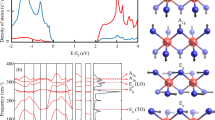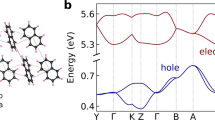Abstract
A RECENT communication by Mooser and Pearson1 has directed attention to the confusion which can result from two distinct usages of the term ‘ionic’. As an example they cite discussions of the bonding in zinc blende, where the tetrahedral bonds may be said to arise from resonance involving (i) Zn2−S2+ and (ii) Zn2+S2−. The first is the extreme covalent structure which gives each atom four valence electrons ; the second is conventionally called the fully ionic structure since both atoms have closed-shell configurations. As Mooser and Pearson point out, both (i) and (ii) are physically ionic, and the convention which describes ‘neutral bonded’ Zn0S0 as 50 per cent ionic, because it involves equal resonance contributions from (i) and (ii), can be most misleading.
This is a preview of subscription content, access via your institution
Access options
Subscribe to this journal
Receive 51 print issues and online access
$199.00 per year
only $3.90 per issue
Buy this article
- Purchase on Springer Link
- Instant access to full article PDF
Prices may be subject to local taxes which are calculated during checkout
Similar content being viewed by others
References
Mooser, E., and Pearson, W. B., Nature, 190, 406 (1961).
Birman, J. L., Phys. Rev., 109, 810 (1958).
Wolff, G. A., and Broder, J. D., Acta Cryst., 12, 313 (1959).
Faessler, A., and Goehring, M., Z. Phys., 142, 558 (1955).
van Wieringen, J. S., Disc. Farad. Soc., 19, 118 (1955).
Jumpertz, E. A., Z. Electrochem., 59, 425 (1955).
Born, M., and Huang, K., Dynamical Theory of Crystal Lattices (Oxford Univ. Press, 1954).
Woods, A. D. B., Cochran, W., and Brockhouse, B. N., Phys. Rev., 119, 980 (1960).
Cochran, W. (to be published). Cowley, R. A. (to be published).
Tolpygo, K. B., Fizika Tverdogo Tela, 2, 2655 (1960). Translation: Soviet Physics, Solid State, 2, 2367 (1961).
Tolpygo, K. B., J. Exp. Theoret. Phys. (U.S.S.R.), 20, 497 (1950).
Dick, B. J., and Overhauser, A. W., Phys. Rev., 112, 90 (1958).
Picus, G., Burstein, E., Henvis, B. W., and Haas, M., J. Phys. Chem. Solids, 8, 282 (1959).
Cochran, W., Advances in Physics, 9, 387 (1960).
Author information
Authors and Affiliations
Rights and permissions
About this article
Cite this article
COCHRAN, W. ‘Effective’ Ionic Charge in Crystals. Nature 191, 60–61 (1961). https://doi.org/10.1038/191060c0
Issue Date:
DOI: https://doi.org/10.1038/191060c0
This article is cited by
-
Skewed electronic band structure induced by electric polarization in ferroelectric BaTiO3
Scientific Reports (2020)
-
Oxidation states and ionicity
Nature Materials (2018)
-
Temperature-dependent infrared reflectivity studies of multiferroic TbMnO3: Evidence for spin-phonon coupling
Pramana (2010)
-
Simulating silicate structures and the structural chemistry of pyroxenoids
Nature (1982)
Comments
By submitting a comment you agree to abide by our Terms and Community Guidelines. If you find something abusive or that does not comply with our terms or guidelines please flag it as inappropriate.



